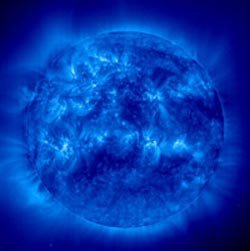Math Unites The Celestial And The Atomic

There is an almost perfect parallel between math describing the motion of celestial objects, like the sun (shown here in an ultraviolet image), and atomic objects. Image courtesy of NASA.
In recent years, researchers have developed astonishing new insights into a hidden unity between the motion of objects in space and that of the smallest particles. It turns out there is an almost perfect parallel between the mathematics describing celestial mechanics and the mathematics governing some aspects of atomic physics. These insights have led to new ways to design space missions, as described in the article, “Ground Control to Niels Bohr: Exploring Outer Space with Atomic Physics” by Mason Porter and Predrag Cvitanovic, which appears in the October 2005 issue of the Notices of the American Mathematical Society.
The article describes work by, among other scientists, physicist Turgay Uzer of the Georgia Institute of Technology, mathematician Jerrold Marsden of the California Institute of Technology and engineer Shane Ross of the University of Southern California.
Imagine a group of celestial bodies—say, the Sun, the Earth, and a Spacecraft—moving along paths determined by their mutual gravitational attraction. The mathematical theory of dynamical systems describes how the bodies move in relation to one another. In such a celestial system, the tangle of gravitational forces creates tubular “highways” in the space between the bodies. If the spacecraft enters one of the highways, it is whisked along without the need to use very much energy. With help from mathematicians, engineers and physicists, the designers of the Genesis spacecraft mission used such highways to propel the craft to its destinations with minimal use of fuel.
In a surprising twist, it turns out that some of the same phenomena occur on the smaller, atomic scale. This can be quantified in the study of what are known as “transition states”, which were first employed in the field of chemical dynamics. One can imagine transition states as barriers that need to be crossed in order for chemical reactions to occur (for “reactants” to be turned into “products”). Understanding the geometry of these barriers provides insights not only into the nature of chemical reactions but also into the shape of the “highways” in celestial systems.
The connection between atomic and celestial dynamics arises because the same equations govern the movement of bodies in celestial systems and the energy levels of electrons in simple systems—and these equations are believed to apply to more complex molecular systems as well. This similarity carries over to the problems’ transition states; the difference is that which constitutes a “reactant” and a “product” is interpreted differently in the two applications. The presence of the same underlying mathematical description is what unifies these concepts. Because of this unifying description, the article states, “The orbits used to design space missions thus also determine the ionization rates of atoms and chemical-reaction rates of molecules!” The mathematics that unites these two very different kinds of problems is not only of great theoretical interest for mathematicians, physicists, and chemists, but also has practical engineering value in space mission design and chemistry.
Founded in 1888 to further mathematical research and scholarship, the 30,000-member American Mathematical Society fulfills its mission through programs and services that promote mathematical research and its uses, strengthen mathematical education, and foster awareness and appreciation of mathematics and its connections to other disciplines and to everyday life.
The Georgia Institute of Technology is one of the nation’s premiere research universities. Ranked among U.S. News & World Report’s top 10 public universities, Georgia Tech educates more than 16,000 students every year through its Colleges of Architecture, Computing, Engineering, Liberal Arts, Management and Sciences. Tech maintains a diverse campus and is among the nation’s top producers of women and African-American engineers. The Institute offers research opportunities to both undergraduate and graduate students and is home to more than 100 interdisciplinary units plus the Georgia Tech Research Institute. During the 2003-2004 academic year, Georgia Tech reached $341.9 million in new research award funding.
Media Contact
More Information:
http://www.icpa.gatech.eduAll latest news from the category: Physics and Astronomy
This area deals with the fundamental laws and building blocks of nature and how they interact, the properties and the behavior of matter, and research into space and time and their structures.
innovations-report provides in-depth reports and articles on subjects such as astrophysics, laser technologies, nuclear, quantum, particle and solid-state physics, nanotechnologies, planetary research and findings (Mars, Venus) and developments related to the Hubble Telescope.
Newest articles

Combatting disruptive ‘noise’ in quantum communication
In a significant milestone for quantum communication technology, an experiment has demonstrated how networks can be leveraged to combat disruptive ‘noise’ in quantum communications. The international effort led by researchers…

Stretchable quantum dot display
Intrinsically stretchable quantum dot-based light-emitting diodes achieved record-breaking performance. A team of South Korean scientists led by Professor KIM Dae-Hyeong of the Center for Nanoparticle Research within the Institute for…

Internet can achieve quantum speed with light saved as sound
Researchers at the University of Copenhagen’s Niels Bohr Institute have developed a new way to create quantum memory: A small drum can store data sent with light in its sonic…





















